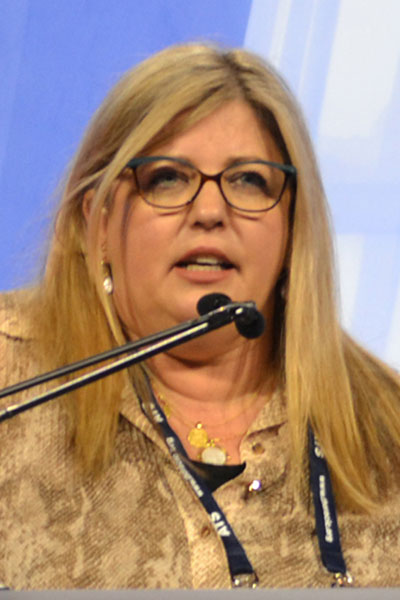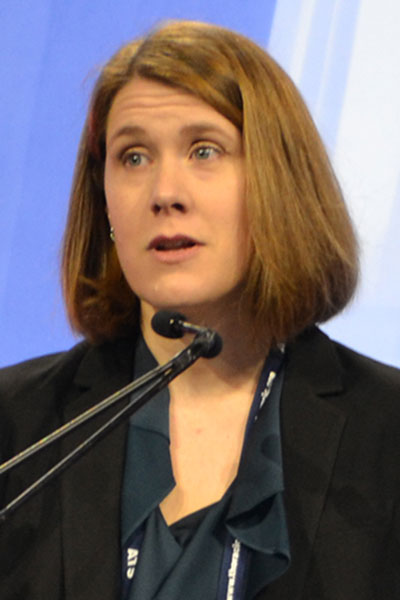The third of four sessions of the annual Clinical Year in Review highlighted the most impactful papers in asthma, sarcoidosis, sepsis, and sleep medicine. This session will be included in the On-Demand Highlights available in the ATS Store this summer.
Asthma

The world of asthma research and treatment is moving from clinically-centered to patient-centered. A new survey of asthma patients, caregivers, and other stakeholders in Australia identified the top 10 national research priorities, starting with asthma in children, COVID-19 and asthma, and asthma care/self-management.
“This research identifies where there are separations between patient priorities and research that is being funded,” said Vanessa Marie McDonald, PhD, professor of nursing and co-director, Priority Research Center for Healthy Lungs, The University of Newcastle, New Lambton Heights, Australia.
A new meta-analysis of five randomized controlled trials and 4,863 adolescent and adult patients supported recent Single Maintenance and Reliever Therapy recommendations. For patients at the Global Initiative for Asthma step 4, SMART reduced exacerbation risk by 29 percent and the rate of severe exacerbations by 22 percent, compared to step-up or continuation of GINA treatment for patients with poorly controlled asthma. For patients at GINA steps 3 or 4, SMART reduced the risk of exacerbations by 30 percent and cut the rate of severe exacerbations by 40 percent.
“Switching to SMART addresses issues of self-management and adherence that we often see in this population,” Dr. McDonald said.
Sarcoidosis

Initial results from the Genomic Research in Alpha-1 Antitrypsin Deficiency and Sarcoidosis study showed that white patients more commonly have pulmonary-only sarcoidosis, while Black patients are more likely to have fibrotic or chronic disease.
Individuals with pulmonary involvement are more likely to be female or Black, and 56 percent have abnormal pulmonary function. Black patients are more likely to have restriction, combined restriction/obstruction, or reduced diffusing capacity for carbon monoxide. Women are more likely to have restrictions.
Black patients show worse lung function, whether measured by forced vital capacity, forced expiratory volume, or DLCO.
A longitudinal study of U.S. and Canadian patients showed clear associations between pulmonary sarcoidosis and indicators of socioeconomic status, including income, education, employment, and housing conditions.
A phase two study of efzofitimod showed good safety and efficacy. The agent inhibits neuropilin 2, a pleiotropic receptor that is upregulated on the surface of activated immune cells that triggers fibrotic pathways.
“This may be an exciting new treatment,” said Michelle Sharp, MD, MHS, assistant professor of pulmonary and critical care medicine, and co-director of the Johns Hopkins Sarcoidosis Program, Johns Hopkins University School of Medicine.
Enrollment for a phase three trial is underway.
Sepsis

Current guidelines recommend 30 mL/kg of crystalloid fluids for sepsis resuscitation, but there is no clear guidance on the next steps in treatment. Two new studies compared restrictive or liberal fluid management in early sepsis-induced hypotension (CLOVERS) and in more severely ill ICU patients (CLASSIC). Neither trial found any differences between the two strategies for survival.
“After that initial resuscitation, it probably does not matter precisely how much fluid you give,” said Siva Bhavani, MD, assistant professor of medicine, Emory University School of Medicine. “These studies tell us that 1-4 liters is helpful, but we don’t know about more. We need to figure out how to individualize treatment beyond this stage.”
The newest emerging therapy in sepsis is selective decontamination of the digestive tract (SDD), a combination of nonabsorbable antibiotics/antifungals and IV antibiotics to prevent ventilator-associated pneumonia. SSD is widely used outside the U.S.
A pilot study of 5,982 patients randomized to SDD or usual care found a nonsignificant reduction in in-hospital mortality for SDD. But the SDD arm showed significant reductions in antibiotic-resistant organisms and bacteremia.
A meta-analysis of 30 trials with more than 24,000 patients showed a risk ratio for mortality with SDD of 0.91 and a 99.3 percent posterior probability that SDD reduces mortality.
Sleep

A key change in the diagnostic criteria for obstructive sleep apnea might be implemented soon. The International Classification of Sleep Disorders requires an apnea-hypopnea index of 15 or more to diagnose OSA. Sleep medicine is dealing with two different thresholds for hypopneas.
The American Academy of Sleep Medicine uses an oxygen desaturation of equal to or greater than three percent from baseline (H3A), while the Centers for Medicaid and Medicare Services requires equal to or greater than four percent (H4) for Medicare coverage. That one percent difference changes the prevalence of OSA from 72–83 percent to 39–47 percent in the same population with equal to or greater than five events per hour.
“H4 leaves people who are sleepy undiagnosed and not qualified for treatment coverage,” said Cathy Goldstein, MD, MS, professor of neurology, University of Michigan Sleep Disorders Center. “Women are underdiagnosed using H4, and younger patients are also disproportionately impacted. And we know that PAP helps patients who have OSA by the H3 criteria.”
The AASM board voted to support the H3A hypopnea criteria, leaving the H4 criteria as “optional.”
Extend Your Learning Beyond San Francisco with ATS 2025 Conference Highlights

With so many valuable educational opportunities offered during the ATS 2025 International Conference, attendees are often forced to decide which sessions to prioritize. That’s why the Society is offering three ATS 2025 Conference Highlights packages for those unable to attend ATS 2025 San Francisco or attendees interested in continuing their education after the conference. Check out the packages and pick the one that’s right for you. Learn at your own pace, whenever and wherever you are!

